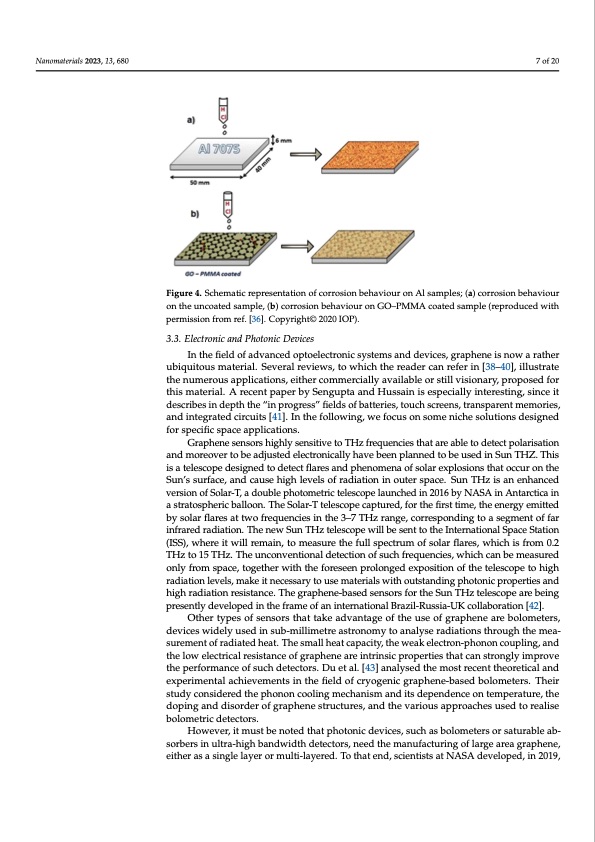
PDF Publication Title:
Text from PDF Page: 007
Nanomaterials 2023, 13, 680 7 of 20 Figure 4. Schematic representation of corrosion behaviour on Al samples; (a) corrosion behaviour on the uncoated sample, (b) corrosion behaviour on GO–PMMA coated sample (reproduced with permission from ref. [36]. Copyright© 2020 IOP). 3.3. Electronic and Photonic Devices In the field of advanced optoelectronic systems and devices, graphene is now a rather ubiquitous material. Several reviews, to which the reader can refer in [38–40], illustrate the numerous applications, either commercially available or still visionary, proposed for this material. A recent paper by Sengupta and Hussain is especially interesting, since it describes in depth the “in progress” fields of batteries, touch screens, transparent memories, and integrated circuits [41]. In the following, we focus on some niche solutions designed for specific space applications. Graphene sensors highly sensitive to THz frequencies that are able to detect polarisation and moreover to be adjusted electronically have been planned to be used in Sun THZ. This is a telescope designed to detect flares and phenomena of solar explosions that occur on the Sun’s surface, and cause high levels of radiation in outer space. Sun THz is an enhanced version of Solar-T, a double photometric telescope launched in 2016 by NASA in Antarctica in a stratospheric balloon. The Solar-T telescope captured, for the first time, the energy emitted by solar flares at two frequencies in the 3–7 THz range, corresponding to a segment of far infrared radiation. The new Sun THz telescope will be sent to the International Space Station (ISS), where it will remain, to measure the full spectrum of solar flares, which is from 0.2 THz to 15 THz. The unconventional detection of such frequencies, which can be measured only from space, together with the foreseen prolonged exposition of the telescope to high radiation levels, make it necessary to use materials with outstanding photonic properties and high radiation resistance. The graphene-based sensors for the Sun THz telescope are being presently developed in the frame of an international Brazil-Russia-UK collaboration [42]. Other types of sensors that take advantage of the use of graphene are bolometers, devices widely used in sub-millimetre astronomy to analyse radiations through the mea- surement of radiated heat. The small heat capacity, the weak electron-phonon coupling, and the low electrical resistance of graphene are intrinsic properties that can strongly improve the performance of such detectors. Du et al. [43] analysed the most recent theoretical and experimental achievements in the field of cryogenic graphene-based bolometers. Their study considered the phonon cooling mechanism and its dependence on temperature, the doping and disorder of graphene structures, and the various approaches used to realise bolometric detectors. However, it must be noted that photonic devices, such as bolometers or saturable ab- sorbers in ultra-high bandwidth detectors, need the manufacturing of large area graphene, either as a single layer or multi-layered. To that end, scientists at NASA developed, in 2019,PDF Image | Role of Graphene in Space Technology

PDF Search Title:
Role of Graphene in Space TechnologyOriginal File Name Searched:
nanomaterials-13-00680-v2.pdfDIY PDF Search: Google It | Yahoo | Bing
Salgenx Redox Flow Battery Technology: Power up your energy storage game with Salgenx Salt Water Battery. With its advanced technology, the flow battery provides reliable, scalable, and sustainable energy storage for utility-scale projects. Upgrade to a Salgenx flow battery today and take control of your energy future.
| CONTACT TEL: 608-238-6001 Email: greg@infinityturbine.com | RSS | AMP |